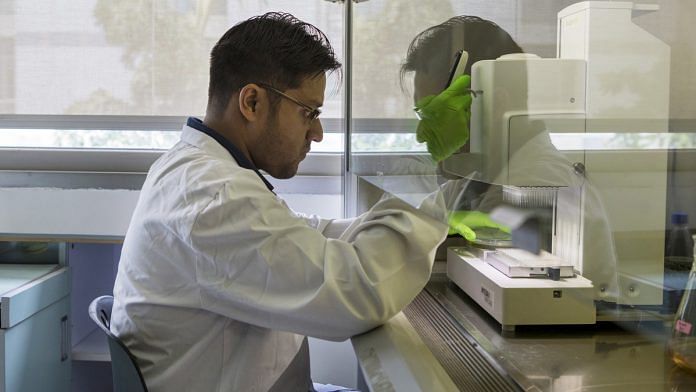Faced with the gravest global challenge in recent times, India’s citizens, government and industry have coalesced in an unprecedented display of collaboration in a ‘whole-of-society’ response to Covid-19. India’s strong response has relied heavily on the rapidly arranged collaborations across the country’s science, technology, innovation and entrepreneurial ecosystems.
However, India’s systems and processes to bring science and technology to market have been historically weak, reflected in a comparatively low – but rapidly rising – rank in the Global Innovation Index. Innovation, firm competitiveness, and economic growth are intrinsically linked, as was demonstrated by Nobel Prize winner Robert Solow’s research. In more recent times, Prof Mariana Mazzucato has demonstrated the critical need for the ‘Entrepreneurial State’, to fund early-stage research and innovation for economic growth.
Innovation-driven economies such as Israel and South Korea spend more than 4 per cent of their respective Gross Domestic Product on research and development, and countries such as the US (2.8 per cent) and China (2.1 per cent) spend substantially higher amounts than India’s 0.6-.0.7 per cent.
Also read: The first Covid vaccines may not prevent you from getting infected
What’s India doing?
While the first indigenous tests came from MyLab, a four-year-old startup with just 55 employees, which is now working with an existing biotech major, the most-visited Covid-19 related website was started by a group of young entrepreneurs. Some existing initiatives of the government, such as the Biotechnology Industry Research Assistance Council (BIRAC) of the Department of Biotechnology, have created models for collaboration, which bore fruit in India’s rapid expansion of efforts to develop a vaccine. This level of productive collaboration at such a scale and so quickly is novel for India, where institutions are designed to operate in a low-trust environment.
However, India needs to do a lot to achieve its full potential. Drawing lessons from the Covid response and gleaning insights from other countries’ support to their innovation ecosystems, a three-pronged strategy to bring together motivation, incentives, and institutions is proposed to further strengthen and inter-connect the science, technology, innovation and entrepreneurial ecosystems.
Also read: This is Kerala’s Ayurveda prescription to fight coronavirus and keep infections down
Motivation
Seeing their research transform a citizen’s life or an industry is already the motivation of many scientists in India. However, structural barriers, or wariness about operating businesses, often dissuade them from thinking about technology commercialisation, despite the potential of profits. Raising awareness in the scientific community about assistance available to them for commercialising technologies would motivate more scientists to start thinking about potential markets during the early stages of technology development.
Some programmes such as those being run by IIT-Madras’ Gopalakrishnan-Deshpande Centre for Innovation and Entrepreneurship and TIME2 at IISc Bangalore’s incubator, are enabling scientists and engineering professors to identify early markets, and motivating them to use early feedback to make their research customer-oriented. Expansion of such efforts and others will help generate more interest in India’s scientific workforce to commercialise their technologies.
Also read: Defence institute develops mask using herbal extract, claims it’s a ‘virus-neutraliser’
Incentives
That incentives drive behaviour is a truism in economics. Hitherto, the career incentives for faculty at most technical institutes in India are oriented solely towards creation of new knowledge and its publication in peer-reviewed journals. Tweaking these incentives to accommodate the academic’s career ambitions while also bringing their technologies to market will spur economic growth. The US’ Bayh-Dole Act in the 1980s, which allowed faculty or a part of their university to hold rights to intellectual property they created, instead of the government or funding agency, motivated engineering faculty to engage with technology transfer offices and corporates, or even start companies on their own, leading to a spurt in innovation in that country.
Arguably, the genesis of modern technology behemoths such as Google in the 1990s is owed to structural changes in how intellectual property was managed at universities and research centres in the 1980s. Some IITs have made some moves in this direction, but a system-wide reform with broad consensus is required, to ensure sustainability of this change.
Also read: India’s Covid peak to arrive mid-November, paucity of ICU beds, ventilators likely: Study
Institutions
Neither interest nor regulatory incentives by themselves would be sufficient, in the absence of institutions that hold knowledge and insights in the technology commercialisation space. Incubation of innovative companies into technology-based enterprises has emerged as a practice in the last one-and-a-half decades, and now there are more than 400 incubators and technology transfer offices in India and more than 4,000 around the world. However, India is still behind the US and China not just in the number of incubators, but also in the services offered by them. The incubators funded by various government and other entities in recent years need to be engaged further in their local science and technology and MSME ecosystems, to facilitate commercialisation of new technologies.
These reforms would be instrumental in attracting more public and private funding for basic and applied research. Creating simple models for innovators, faculty and startups to develop and commercialise products will also attract technology risk funding, an important driver for economic growth around the world in recent years.
For India’s recovery, institutionalisation and expansion of this culture of cross-sector collaboration and collective action is critical, with the State playing a convening role. The road to making India an innovation-driven nation is long, and the first few milestones have been crossed. It’s now time to learn from the current crisis, and institutionalise some newly discovered methodologies that can accelerate in bringing achievements from India’s labs into the hands of the citizens.
Mudit Narain is Program Director, Atal Innovation Mission, NITI Aayog. Views expressed are personal.



